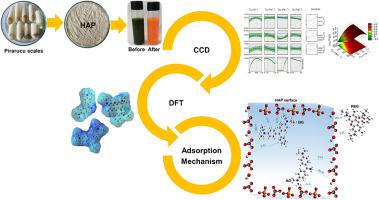Sustainable Materials and Technologies ( IF 8.6 ) Pub Date : 2022-01-19 , DOI: 10.1016/j.susmat.2022.e00391
Emanuele D.V. Duarte 1 , Giani V. Brião 2 , Nielson F.P. Ribeiro 1, 1 , Meuris G.C. da Silva 2 , Melissa G.A. Vieira 2 , Samira M.L. de Carvalho 1, 1

|
The simultaneous-competitive adsorption of Auramine-O (AO), Rhodamine 6G (R6G), and Brilliant Green (BG) dyes onto hydroxyapatite (HAP) produced from pirarucu (Arapaima gigas) scales was investigated by Fourier Transform Infrared (FTIR), Central Composite Design (CCD), and Density Functional Theory (DFT). Pirarucu scales were chosen as the precursor of the bioadsorbent owing to the large volume of this unutilized waste produced by the Brazilian pisciculture, which has increased the concern about solid disposal in the Amazon region. The CCD matrix presented each dye initial concentration as a factor influencing the removal of the other dyes. DFT was utilized to indicate the preferential order of adsorption. FTIR analyses of the dye-adsorbed HAP confirmed that the cationic dyes were removed from aqueous solution owing to interactions with anionic groups present on the HAP surface. High values of BG initial concentration negatively influenced the adsorption of AO, according to CCD, DFT, and FTIR results. Desirability analysis based on CCD results revealed the simultaneous optimum conditions of the ternary adsorption to be: HAP dosage 1.09 g.L−1; AO, R6G, and BG initial concentration 77.29, and 39 mg.L−1, respectively, yielding percentage removals of AO, R6G, and BG as 93.78%, 23.94%, and 99.94%, respectively. The adsorption isotherms at 28, 38, and 48 °C suggested that the dyes in the ternary mixture were adsorbed in monolayer on the HAP surface (modified Langmuir model). The CCD, DFT, and FTIR studies effectively aimed to propose the possible multicomponent adsorption mechanism. This study shows that pirarucu scales is a residue biomass that can be easily processed to obtain an efficient, low-cost, and selective adsorbent regarding the studied dyes.
中文翻译:

Auramine-O、Rhodamine 6G 和 Brilliant Green 在巨巨巨骨舌鱼鳞片羟基磷灰石上的三元吸附:使用 CCD 和 DFT 研究的吸附机理研究
Auramine-O (AO)、Rhodamine 6G (R6G) 和 Brilliant Green (BG) 染料同时竞争吸附到由 pirarucu ( Arapaima gigas ) 生产的羟基磷灰石 (HAP) 上) 尺度通过傅里叶变换红外 (FTIR)、中心复合设计 (CCD) 和密度泛函理论 (DFT) 进行了研究。Pirarucu 鳞片被选为生物吸附剂的前体,因为巴西养鱼业产生了大量这种未利用的废物,这增加了亚马逊地区对固体处置的关注。CCD 矩阵将每种染料的初始浓度表示为影响其他染料去除的一个因素。DFT用于指示吸附的优先顺序。染料吸附的 HAP 的 FTIR 分析证实,由于与 HAP 表面上存在的阴离子基团的相互作用,阳离子染料从水溶液中去除。根据 CCD、DFT 和 FTIR 结果,高 BG 初始浓度值对 AO 的吸附产生负面影响。-1 ; AO、R6G 和 BG 的初始浓度分别为 77.29 和 39 mg.L -1,AO、R6G 和 BG 的去除百分比分别为 93.78%、23.94% 和 99.94%。在 28、38 和 48 °C 的吸附等温线表明,三元混合物中的染料单层吸附在 HAP 表面(改进的 Langmuir 模型)。CCD、DFT 和 FTIR 研究有效地旨在提出可能的多组分吸附机制。这项研究表明,pirarucu 鳞片是一种残留的生物质,可以很容易地加工以获得关于所研究染料的高效、低成本和选择性的吸附剂。

































 京公网安备 11010802027423号
京公网安备 11010802027423号